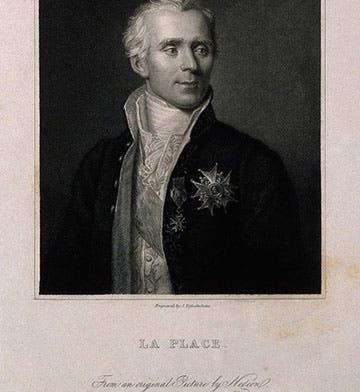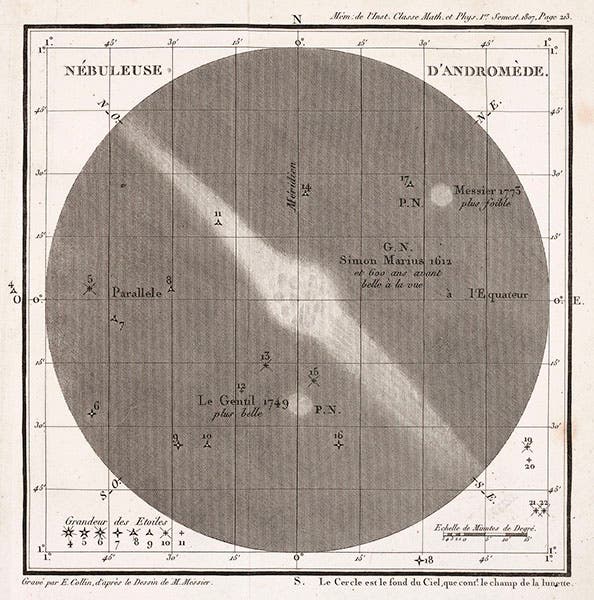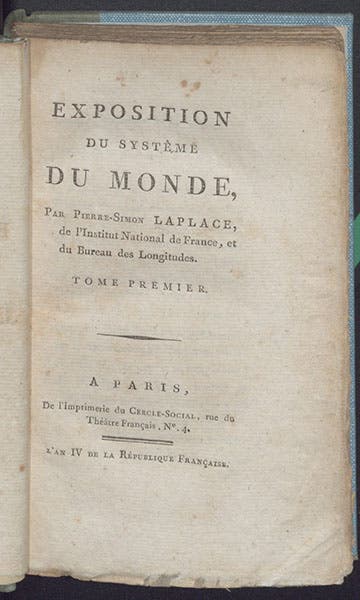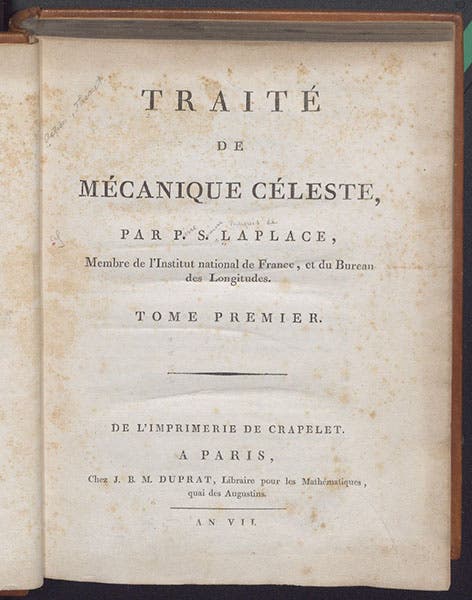Scientist of the Day - Pierre-Simon Laplace
Pierre-Simon Laplace, a French mathematician, was born Mar. 23, 1749. Laplace was a brilliant mathematical physicist, the French sequel to Isaac Newton. He did important work in celestial mechanics, refining Newton's work, but those accomplishments, mathematically based, are hard for most of us to comprehend. But one of his most significant achievements is relatively easy to understand and appreciate. Laplace proposed and worked out the details of what is commonly called the "nebular hypothesis" on the origin of solar systems.
Nebulae, in Laplace's time, were tiny smudges in the sky, visible only in a telescope, that could be any shape, but were often circular or elliptical. They became important objects of study with the work of , who catalogued over 100 of them in 1781. We see above Messier’s drawing of the great nebula in Andromeda (second image). No one knew what nebulae were. Laplace proposed that nebulae are future solar systems, waiting to happen. Assuming that nebulae are large congregations of gas and dust, Laplace was able to demonstrate that the action of gravity would cause them to contract, and the law of the conservation of angular momentum, coupled with centrifugal force, would cause the shrinking nebulae to rotate faster and faster, and flatten out into thin spinning disks. Eventually, the outer edges of rotating disks would break off to form rings, and the rings would condense into planets, with the central core becoming the sun. Such a process would produce a solar system laid out in a flat plane, with all the planets orbiting in the same direction, which is exactly the kind of system that we happen to inhabit.
Laplace's nebular hypothesis was first proposed in his Exposition du système du monde (On the System of the World, 1796), which we have in the History of Science Collection (third image, just above). We have several editions of this work in our collections; the 1808 edition has an engraved portrait, but I forgot to have it scanned, so we have to settle for a portrait in the Wellcome Collection (first image). Laplace's nebular hypothesis is still, with some modification, the prevailing hypothesis for the origin of stars and planetary systems.
Laplace subsequently wrote a more technical work, Traité de mécanique céleste, the first volume of which appeared in 1798, with four more volumes coming out over the course of the next 27 years (fourth image, just above). This was the work famously translated by the Scottish mathematician Mary Somerville. At the time we wrote our post on Ms Somerville, we did not have her translation in our collections, but we have it now: Mechanism of the Heavens (1831), considerably slimmer and easier to comprehend than the original.
Laplace died in 1827. He was originally buried in Père Lachaise in Paris, but he was later moved to the family estate in Normandy, where an elaborate tomb was erected. As we find this memorial unmemorable, we show instead another legacy, his inclusion on the frieze just below the first level of the Eiffel Tower, where you can see his name at the left, just next to that of Georges Cuvier (fifth image, just above).
Dr. William B. Ashworth, Jr., Consultant for the History of Science, Linda Hall Library and Associate Professor emeritus, Department of History, University of Missouri-Kansas City. Comments or corrections are welcome; please direct to ashworthw@umkc.edu.










